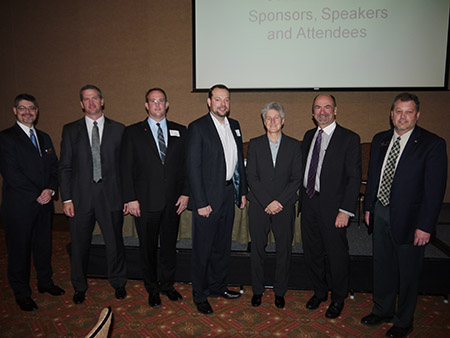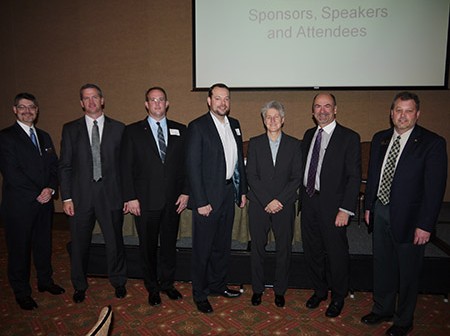Bend Chamber Economic Forecast panelists point to positive signs. An air of cautious optimism was evident during the recent Bend Chamber-sponsored Economic Forecast Breakfast as contributors from key sectors weighed up factors affecting everything from regional employment to consumer sentiment, real estate and education.
Billed as Vision 2014: State of the Market & Beyond, over 350 attendees at Bend’s Riverhouse Convention Center including business and community leaders heard insightful and generally positive feedback on economic prospects from guest panelists including Roger Lee (executive director of Economic Development for Central Oregon) Becky Johnson (OSU-Cascades vice-president) Kris Scholl (Deschutes Brewery technical director) and Brian Fratzke (principal of Fratzke Commercial Real Estate).

(L-R) Bend Chamber President & CEO Tim Casey, EDCO Executive Director Roger Lee, Fratzke Commercial Real Estate Principal Brian Fratzke, Deschutes Brewery Technical Director Kris Scholl, OSU-Cascades Vice-President Becky Johnson, Principal of Ferguson Wellman Capital Management Mark Kralj and Bend Chamber Board Chairman Kyle Frick.
The annual event was moderated by Mark Kralj, principal of Ferguson Wellman Capital Management.
Kralj opened by observing “steady but uninspiring job growth” in the U.S. currently, with the nation fighting to claw back employment eroded during the “Great Recession” and still two-and-a-half million jobs off the previous peak.
The labor participation rate was at its lowest in 35 years, with some job seekers just “giving up” despite the massive government stimulus effort – which Scholl saw as having created more of a wealth effect toward the already well-off rather than spilling over into the general economy.
Lee said pressure on job creation in the manufacturing arena was exacerbated due to greater production being undertaken by fewer people, in part due to technological advances, while Johnson confirmed the “counter-cyclical” tendency for student enrolment to rise during economic downturns.
Johnson said there had been much discussion regarding the merits of ‘STEM’ (science, technology, math and engineering) designated degree programs, and OSU-Cascades was focused on bringing more tuition of this type on board, adding: “We just started a computer science degree this fall partly in response to the Central Oregon economy and input from business leaders, particularly in the hi-tech sector.
“We have heard from businesses how difficult it is to get software engineers and so forth. It’s hard to get people to come to Bend where wages are generally lower, but if you grow up here you are much more likely to stay and work here and we can grow our own talent.”
Lee said recovery in the Bend Metropolitan Statistical Area (MSA) was still uneven, but pointed to longer-term trends showing a 13.5 per cent growth in annual non-farm employment over the last decade, and the fact that EDCO had just celebrated the best quarter in its 32-year history of business recruitment, with 14 deals put in place, providing “a lot of optimism moving forward”.
Scholl added that craft brewing was an acknowledged bright spot in the manufacturing sector of the U.S. economy, with Central Oregon particularly well-placed as a hotbed of the industry. He said: “When we look at our expansion plans, we note that a one percent decrease in business for the ‘mega-brewers’ represents a potential 14 per cent increase in craft beer volume, and consumer preferences are changing.”
Touching on the economic effects of the development of a four-year OSU-Cascades campus envisaged for Bend’s Westside and being readied for the first freshman class of 2015, Johnson said nine jobs were estimated to be created for every million dollars of construction, with her institution’s efforts complementing those already underway at Central Oregon Community College in terms of providing expanded employment.
An OSU study also showed that on average students spend some $11,000 a year outside of the university environment, helping further boost the local economy.
State college leaders also expect the evolving OSU-Cascades campus to play a major role in helping meet Governor Kitzhaber’s goals for higher education participation among Oregonians by 2025, as well as an anticipated increasing enrolment by international students, for whom a U.S. degree is still highly prized.
In looking at the question of why soaring U.S. corporate profits, partly due to strengthened balance sheets and debt consolidation, were not equating to a correspondent increase in hiring, panelists speculated that there was still widespread uncertainty over future national policy.
Many businesses considering a move or already established in the area were waiting to make significant moves with their capital reserves until seeing more certainty in areas such as health care and interest rates. “We talk to companies and they say ‘we are not going to get caught unaware without protection for what’s coming down the road,’ ” said Lee.
He added that his group was predicting a possible shorter-term recessionary blip mid next year to early 2015, partly due to a likely rising interest rate trend and health care costs and EDCO was monitoring the situation, but was also anticipating that once adjustments were made the economy could gain traction and “power through” from 2016-19.
REAL ESTATE FRONT
On the real estate front, the climate was markedly improving. In the commercial arena, Fratzke said tenants were still aggressively negotiating leases, but light industrial space in Bend was being “gobbled up,” with vacancy rates in the sector being pushed down to under eight per cent compared to the 20 per cent mid-recession peaks, and users eyeing Redmond as having larger affordable potential future capacity.
He said often prospective business operators on average were looking for relatively smaller space, adding: “These are tenants that brought their intellectual property with them and they are looking to start their business.
“I support our major employers, but if you look at the two to four-person businesses, that has really made a big impact on the absorption of our commercial real estate.
“There has been a migratory shift going on in this country for the last five years where people value moving to a community where they can be accepted and Bend is that community.
“Creating jobs can be challenging, but our community supports careers. We have many positive factors, including COCC, an emerging Pac-12 university, vibrant venture capital sector, as well as an engaged business community supported by dynamic organizations like EDCO and the Chamber. People have a greater chance to become established here and build a career, which is encouraging for the future.”
Fratzke observed a tight residential rental market hovering under one per cent vacancy rate, but with some 2500 units anticipated to come on line in the near future rental rates could start to decline after an extended period of strengthening due to previous relative scarcity of supply.
He also anticipated scant new office development as there was a seemingly adequate current supply and businesses were looking at more efficient concepts such as “hoteling” where workers plug in an connect in shared space rather than the traditional personalized office environment.
On the residential side, the numbers were increasing for purchases, though panelists noted the high proportion of speculative investors and cash buyers. Affordability for first-time homebuyers was a concern, especially if rising interest rates were to dampen a nascent housing recovery.
Lee said longer-term population growth in the Bend-La Pine School District area was positive and up 19.4 per cent between 2003 and 2013, whereas other comparable areas in the state were contracting and even looking at closing schools, illustrating that it was not just predominantly retirees moving to the area.
Bend currently has a relatively short housing supply inventory especially considering the lack of recent construction activity, but Fratzke said he hoped that an enlightened approached to expanding the Urban Growth Boundary (UGB) could relieve future land cost pressures and promote potential housing affordability.
Kralj said the consumer “was on the mend” and had in general been paying down debt and improving the household balance sheet, with auto sales also on the rise as assets were replaced, though unit labor costs had not grown and wages were on average less than that of five years ago.
Access to capital was also strained and putting pressure on credit availability.
There was optimism in the U.S. manufacturing sector after years of decline and job losses, as increasing wages and other pressures in Asia has seen the delta between domestic and overseas opportunities narrowing.
Given the complexity of moving and increased technological efficiencies together with perceived decreased benefits of switching abroad, there was an emerging “industrial renaissance” in America; especially in relation to the country’s increasing energy independence with consequent anticipated more competitive operating costs.





